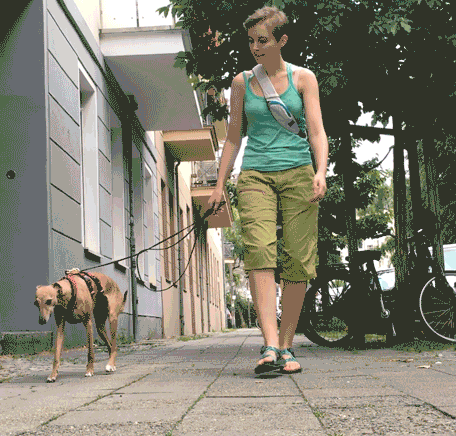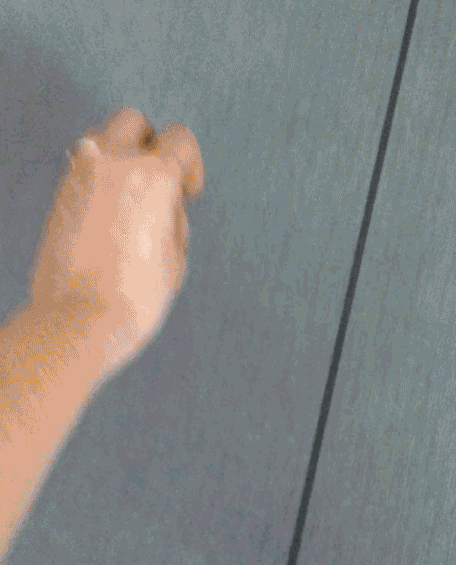The almighty Hand Target
Side switch using a hand target, a useful skill for reactive dogs.
Walking past temptations with a hand target
Please let me introduce you to my lord and saviour, the hand target.
What's this?
It's a trained behaviour. The dog moves their nose towards and follows your open hand, no matter what distractions are around, no matter how far away they are.
What's it good for?
Uhhh the better question would be what's it not good for!
It is an ideal first behaviour to train when you’re starting with marker training because it shows the dog that their deliberate actions can earn them rewards. Plus you can practice getting your timing right and learn to juggle your hand, the clicker/marker-word and the treats.
It can replace luring with food.
It can be utilised in any situation or training goal in which you want the dog to move somewhere. Go to bed? Hand target. Jump in the car? Hand target. Heel? Hand target! Walk past a distraction? Hand target. Switch sides while walking (very useful for reactivity)? Say it with me, hand target! Weave through legs? Hand target. Come when called? Hand target! Step on the scales at the vet office? Hand target.
Helps with learning default leave-it. When training the hand target, you’ll have treats nearby, either in your other hand, your pocket, or on a nearby tabletop. The dog is therefore automatically learning to ignore those temptations and target the hand instead. You may think “well he can’t reach those treats anyway” but he could still jump up and try to get them, licking and nudging at your hand or pocket, etc. So in training the hand target, you’re also reinforcing the very first steps of leaving distractions alone in favour of working with you, and soon continuing to do so even when distractions are within reach.
Alternative behaviour. The hand target gives the dog a deliberate thing to do. So when they are having a hard time resisting a temptation, the hand target is useful as an incompatible alternative behaviour.
Trust built-in. The hand target should be a promise- something good is going to happen if you follow, nothing scary. The more that association builds, the more you can also use it in situations where your dog is a little anxious about something. "Oh gosh, that thing looks a bit daunting... hm, but my human is giving the hand target, so it must be okay like it was the last 200 times we did that!" Use this with care because if you break that trust, you can create the opposite association, see below.
What is it not good for, are there pitfalls?
The hand target is a promise, a job opportunity. Target the hand, and good things are likely to happen. If you “trick” your dog with the hand target, they will start to distrust it. So if your dog hates baths, then don’t hand-target them into the bathroom for bathtime. Don’t waste the good vibes you’ve build up on that- instead first tackle the problem separately (ie making baths more cooperative, but that’s for another post).
A common error is holding your hand too high, so the dog jumps or comes up on their back legs to reach it. Hold your hand low enough for them to reach while all paws remain on the floor, or click before they jump. Otherwise you’ll start seeing more of jumping up.
Mouthy or over-excited dogs can get into the habit of mouthing or nipping your hand. Solution: Train when the dog is more relaxed, mark earlier. The dog should be approaching but not yet touching your hand, and their mouth shouldn’t be open in preparation of mouthing your hand. Essentially you’re training “get your nose in the general vicinity of the hand” rather than “actually touch the hand.”
The hand target should also be a question. “Can you approach my hand in this situation?” A question must be able to take ‘no’ for an answer- otherwise it’s not a question. If you ask, and the dog doesn’t do so, and in response you force them, you’re poisoning the cue. It’s no longer a question, it is a threat: “if you don’t, I will make you.” Poisoned cues cause stress and damage trust. If someone taught you “go to your room” by dragging you by the ear, your blood may still run cold when you hear that phrase, even years later. Solution: make it easier next time you ask (fewer distractions, less distance) so they can succeed and grow from there.
When using the hand target to springboard to other behaviours, it acts as a shortcut, meaning results can be sloppy. Often that’s not a problem, or it’s something that can be cleaned up later.
For instance: If you wanted to train heel to competition-obedience-grade, rather than “merely” good-enough-for-casual-walkies-grade, you may want a few additional building blocks in your training protocol. It all depends on your goals.
Here is a great example of the hand target in action, in unison with the beginnings of a default leave-it. Many thanks to Kai’s humans for posting this video!
Notice how Kai is trying so hard to not eat the decoy kibbles- whining, looking away, offering a down- and once he gets the task of the hand target, he jumps at the opportunity. It gives him something to do and provides a “legitimate” way to earn a treat for doing the right thing.
@laurasfosters puppy training video is another example. Notice how many tricks start with following a hand (crawl, jump through hoop), and this little pup already has the start of a recall to the hand target going.
Of course you want to build up a default-leave it to everyday sidewalk temptations without having to use the hand target every single time, but this is how you can start out. The more you hand target past distractions, the more your dog will view distractions as a cue to look to you, because hopefully you’re about to present your hand. The behaviour of orienting to you and following you past the distraction can then be marked in itself. You can later use a release word (a signal meaning “ok dog, you can go sniff the trees again”), thus using access to the environment as the reward for ignoring the distraction.
Even so, every now and then the world sends us temptations we couldn’t prepare for. Dead birds, rabbit poop, a whole Döner, a bag of popcorn spilled all over the sidewalk. A dynamite hand target loaded up with lots of reinforcement-history can be your go-to way to move through difficult situations.
This works for edible temptations (or, sigh, what our dogs deem edible…) as well as other distractions. For dogs who want to greet everyone, or who bark and lunge at others. The hand target can help you position your dog on the side farthest from the distraction without having to drag them, and give them an alternate behaviour to do instead.
I’m sold, how do I train this?
Most dogs will sniff towards an offered hand. So offer them a hand nearby (but not pushed in their face), mark (click, or use your verbal marker) any little look or sniff towards the hand.
Expand the distance the dog will cover. First present hand so they only have to crane their neck to reach it, then so they have to take a step, etc.
Reaching a stationary hand is different from following a hand that’s moving. So gradually mix in some of the latter.
Once the dog has learned the basics, let’s take this show on the road. Try it when there’s a distraction or from further away, in different environments, and so forth.
If at any point the dog struggles, then go back to an easier step and try to think of an intermediate step between what worked and what didn’t.
Presenting your flat hand (and maybe wiggling your fingers) is itself the cue for the behaviour. You can however also add a verbal to it, so that even if your dog is not looking at you, they know that “touch” means to look to the human because there’s about to be a hand target job opportunity :)
…but what if I don’t want to keep using hand target for everything?
Good point. Let’s take go-to-bed as an example. You want to end up saying “bed” rather than having to hand target your dog onto their bed every time till the end of time. Good news- you can use the hand target to “springboard” onto other cues.
Behaviours that start out with the hand target can “spin-off” from that foundation.
You might first use the hand target to get them going on their bed, but then put the new “bed!” verbal cue in front of that and fade out the hand target.
Cue transference 1-2-3-4:
Use hand target to initially get the behaviour. The dog may at first not fully know what they’re doing beyond following the hand. They may be thinking “follow the hand, the hand!” without realizing that oh, they happen to be stepping on the bed in the process. That’s okay for a start. We can mark when their feet step onto the bed to highlight that now the criteria is actually about the bed and not the hand.
Add the new cue in front of the hand cue. So: “Bed”, of course the dog looks at you like “??? I don’t know this one?” and then follow up with hand target to the bed. Note: Timing is vital. If you give both signals at the same time, the dog may not learn the pattern. They’ll simply watch for the known signal (the hand) and disregard the unknown new signal (“bed”).
“Bed” and then… wait a few seconds to see if the dog predicts the pattern. If they don’t, simply help them out with the hand target. If they so much as tentatively walk towards the bed, mark and reward them! Repeat till reliable.
Refine other aspects of the behaviour. This is where the “spin-off” gains independence and fluency. In this case, that might mean asking the dog to “bed” from further away, during varying levels of distraction and excitement, building up the duration they’ll stay for, introducing a release cue, and so forth.
Source: ASCO Target Stick on Amazon
I have a small dog and/or a bad back, help!
There’s telescopic target sticks for that, some with integrated clickers.
Alternatively, you could simply train when sitting down to put yourself at your dog’s level, and later stand up and mark your dog for following under your hand without jumping up. A sort of shadow-hand target.



